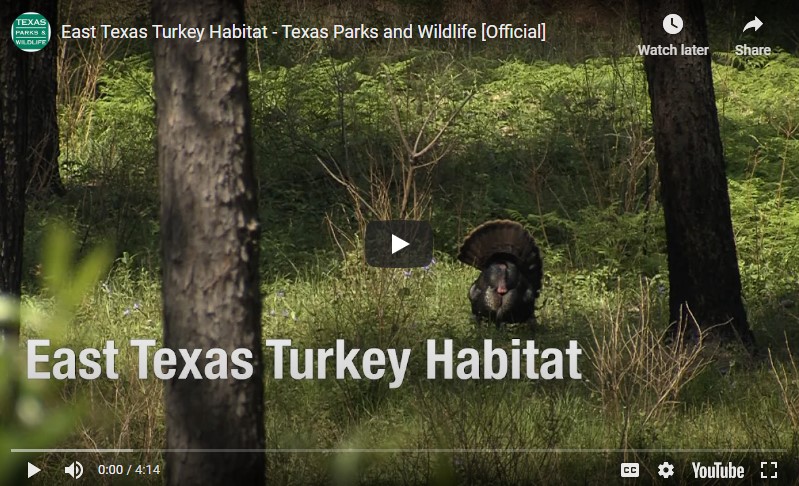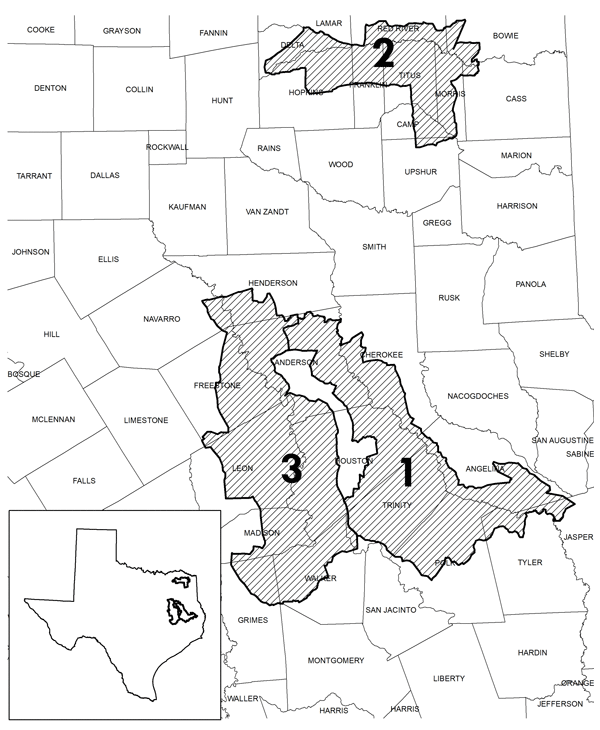Eastern Wild Turkey Restoration Program
The eastern wild turkey was once numerous in east Texas. However, due to rapid changes in habitat and unregulated harvest the eastern wild turkey was extirpated from the state around the turn of the 20th century. Early attempts at restoration utilized pen reared turkeys and later the Rio Grande subspecies. Both methods failed to create a sustainable turkey population. Texas Parks and Wildlife Department began releasing wild trapped eastern turkeys from neighboring states in 1979. By 2003, over 7,000 wild turkeys had been stocked into east Texas utilizing a block stocking approach. Block stocking called for the release of 15 to 20 birds per site with 5 to 10 release sites per county. These restorations were successful in several areas, but many more failed to create sustainable populations.
TPWD funded research through Stephen F. Austin State University in 2007 to test a super stocking model for restoring turkey populations. After 3 years of research, this method has shown considerable merit. In 2014 TPWD reopened the Eastern Wild Turkey Restoration Program.
Requirements for Eligibility
- TPWD is focusing restoration efforts in three Priority Areas:
- Neches River Priority Area: Neches River and White Rock Creek watersheds within Anderson, Angelina, Cherokee, Houston, Jasper, Polk, Trinity and Tyler Counties.
- Sulphur River Priority Area: Sulphur River, White Oak Creek and Cypress Creek watersheds within Bowie, Camp, Cass, Delta, Franklin, Hopkins, Morris, Red River, Titus and Upshur Counties.
- Trinity River Priority Area: Anderson, Freestone, Grimes, Henderson, Houston, Leon, Madison, Navarro, Trinity and Walker.
- Restoration sites must consist of a minimum of 10,000 acres of contiguous usable habitat. Proposed restoration sites may consist of multiple landowners. Restoration sites consisting of multiple landowners must demonstrate a level of cooperation among landowner members.
- Request for restoration must be submitted by the landowner or their agent and must have management authority of the property.
- Individuals must make a request for restoration in writing to TPWD’s Upland Game Bird Program. Request should be emailed to Jason Hardin or mailed to P.O. Box 279; Buffalo, TX 75831.
- Proposed restoration sites must hold a meeting with TPWD staff present before TPWD can move forward with the evaluation process.
- Prior to a stocking, release sites must possess a TPWD approved Management Plan and demonstrate management activities beneficial to wild turkeys.
- Contact your local TPWD wildlife biologist for more information.
Wild Turkey Priority Areas
Neches River Priority Area (1)
The Neches Priority Area includes portions of the Neches River and White Rock Creek watersheds within Anderson, Angelina, Cherokee, Houston, Jasper, Polk, Trinity and Tyler Counties.Sulphur River Priority Area (2)
The Sulphur River Priority Area includes portions of the Sulphur River and Cypress Creek watersheds within Bowie, Camp, Cass, Delta, Franklin, Hopkins, Morris, Red River, Titus and Upshur Counties.Trinity River Priority Area (3)
The Trinity River Priority Area includes portions of the Trinity River watershed in Anderson, Freestone, Grimes, Henderson, Houston, Leon, Madison, Navarro, Trinity and Walker Counties.

